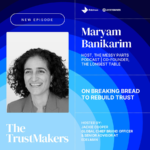By Cristy Garcia, CMO at impact.com
Marketers today are navigating a perfect storm. According to the Consumer Confidence Board, consumer confidence has plummeted to a twelve-year low—a clear signal that many people are pulling back on spending. At the same time, the political landscape is increasingly volatile. With the threat of new tariffs looming, the cost of producing goods could spike, further disrupting supply chains already under pressure. In short, marketers are being squeezed from every direction, forced to adapt in real time to forces largely outside their control.
The result will be major market turbulence. Some products, like cars and electronics, threaten to become more expensive in the near future and may not even be available if the supply chain is strained. This could make consumers buy now to avoid higher prices or long waits later. However, consumer caution could also mean that people trade down to less expensive options, delay purchases, or go without.
All of this uncertainty has marketers wondering what to do with their budgets. If they stop spending, they can save on cost in the near term, but they sacrifice reaching consumers who are buying, which could impact growth. If they spend too much, they worry about having to report negative results to their executives.
Avoid The Marketing Comfort Zone
In this market, the most common thing for businesses to do is pull back on parts of their marketing budget such as testing new innovations, branding, and higher-priced placements. Many marketers move to “comfort zone” marketing, including discounting to drive sales, and marketing in low-cost channels to save on near-term costs. Marketers often cut test budgets and hold off learning about new innovations for fear they will waste their budget.
While some of these protectionist tactics can be beneficial, especially in the short term, marketers will start to see reduced volume if they adhere to them for too long.
- Avoiding brand-based spending will decrease awareness and consideration, decreasing the number of new consumers exposed to the brand.
- Discounting will train consumers to expect lower prices, straining margins and making it difficult to drive full-price sales.
- Focus on low-cost channels ignores metrics that might indicate higher-priced channels actually drive higher real outcomes.
- Ignoring innovations puts marketers behind competitors that forged ahead with testing
Marketers who become overly protective and pull back too much could decrease their growth potential coming out of a tough market. There are many examples where spending during a recession or during market uncertainty can be very beneficial and help brands push ahead of their competitors.
Growing When Everyone Else Shrinks
There are a number of things marketers can do to not only protect themselves but also set themselves up for longer term growth.
- Diversify with partnership-led strategies. While discounts and deals will drive immediate sales, bargain hunters aren’t the only audience partners can reach. Partners like influencers and affiliates know their audiences best and can work with marketers to create strategies that deliver both engagement and sales for specific audience segments Partners often have the insights needed to present different offers to target audiences that can drive higher margins, like giving loyal shoppers unique content or a first look at a new product line rather than a discount that they might not care about.
- Lean into tactics and channels that deliver results and reliability. Most marketers agree that influencer marketing is highly effective and spend will continue to grow significantly even in an uncertain market because consumers trust influencers to guide their spending. Brands can and should continue with influencer marketing, and even leverage their broader affiliate marketing strategy to hedge against market turmoil by diversifying their plan. Working across platforms, diversifying partnerships, and working with influencers across different tactics, not just sponsored content, are two examples. Pay-for-performance agreements with partners is another example of an effective tactic that is proven to create a reliable way for brands to invest in growth without risk.
- Measure and market to the whole funnel. While lower funnel marketing, including affiliate marketing, is easy to measure, marketers need to remember that they need to invest in quality partnerships to drive interest and awareness. Consider partners that include social content for a wide audience as well as offers and discounts to drive sales, for example. Even the most effective lower funnel marketing requires additional messaging to a broader range of consumers to drive conversion.
- Continue to test. Consider two huge changes happening. First, the effect AI will have on marketing over the next two years is huge. Marketers who allow this surge of innovation pass them by due to concerns over economic uncertainty will come out behind. Second, GenZ is moving into adulthood, getting jobs, buying homes and making major life decisions. No matter what the market does, these changes require marketers to evolve. Now is the time to automate and create efficiency, test opportunities to target more precisely, create more personalized messaging and build more effective cross-channel campaigns.
Build a Market-Proof Plan
Creating a smart marketing plan in an uncertain economy builds on the “comfort zone” in a few ways. Marketers should work with their key partners to ensure they continue to drive incremental sales. Ask about the most effective ways to move “up-funnel” with additional marketing that supports those foundational marketing elements.
Marketers should also use this time to become more adept at measurement and testing. Effective measurement goes beyond clicks and impressions to truly see where incremental lift is coming from so it’s possible to invest more confidently in the tactics that are driving growth – even new tactics like AI. This also empowers marketers to move beyond discounts, testing targeted messaging and message segmentation that can increase margins and LTV.
With a cautious but optimistic approach, marketers can not only withstand the perfect storm; they can chart a path through it. Growth is still possible, even in the unpredictable economy of 2025 and beyond.











